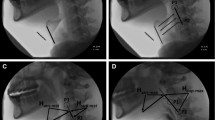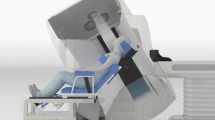Abstract
This study investigated the effects of Mendelsohn maneuver with three-dimensional kinematic analysis. Nine female speech-language pathologists (nine females, mean ± SD 27.1 ± 3.5 years old) underwent 320-row area detector scan during swallows of 4-ml nectar-thick liquid using with no maneuvers (control) and with Mendelsohn maneuver (MM). Critical event timing (hyoid, soft palate, epiglottis, laryngeal vestibule, true vocal cords (TVC), UES), hyoid and laryngeal excursion, cross-sectional area of UES, and volume of pharyngeal cavity and bolus were measured and compared between two swallows. In MM, all the events were significantly prolonged with delayed termination time (p < 0.05) except UES opening. The onset, termination, and duration of UES opening were not significantly affected by MM nor was timing of bolus transport. The hyoid bone was positioned significantly higher at maximum displacement (p = 0.011). Pharyngeal constriction ratio was 95.1% in control and 100% of all subjects in MM. Duration of minimum pharyngeal volume was significantly longer in MM than in control (p = 0.007). The MM produces several distinct changes in the kinematics of swallowing in healthy subjects with no dysphagia. The changes in the timing and magnitude of hyoid displacements and prolonged closure of the pharynx during swallowing suggest the utility of MM for improving the safety and efficiency of swallowing in selected cases.









Similar content being viewed by others
References
Kahrilas PJ, Logemann JA, Gibbons P. Food intake by maneuver; an extreme compensation for impaired swallowing. Dysphagia. 1992;7(3):155–9.
Kahrilas PJ, Logemann JA, Krugler C, Flanagan E. Volitional augmentation of upper esophageal sphincter opening during swallowing. Am J Physiol. 1991;260(3 Pt 1):G450–6.
Logemann JA, Kahrilas PJ. Relearning to swallow after stroke–application of maneuvers and indirect biofeedback: a case study. Neurology. 1990;40(7):1136–8.
Lazarus C, Logemann JA, Gibbons P. Effects of maneuvers on swallowing function in a dysphagic oral cancer patient. Head Neck. 1993;15(5):419–24.
Kahrilas PJ, Dodds WJ, Dent J, Logemann JA, Shaker R. Upper esophageal sphincter function during deglutition. Gastroenterology. 1988;95(1):52–62.
Cook IJ, Dodds WJ, Dantas RO, Massey B, Kern MK, Lang IM, et al. Opening mechanisms of the human upper esophageal sphincter. Am J Physiol. 1989;257(5 Pt 1):G748–59.
Jacob P, Kahrilas PJ, Logemann JA, Shah V, Ha T. Upper esophageal sphincter opening and modulation during swallowing. Gastroenterology. 1989;97(6):1469–78.
Logemann JA. Evaluation and treatment of swallowing disorders. 2nd ed. Texus: PRO-ED, Inc; 1998.
Lazarus C, Logemann JA, Song CW, Rademaker AW, Kahrilas PJ. Effects of voluntary maneuvers on tongue base function for swallowing. Folia phoniatrica et logopaedica. 2002;54(4):171–6.
Boden K, Hallgren A, Witt Hedstrom H. Effects of three different swallow maneuvers analyzed by videomanometry. Acta Radiol. 2006;47(7):628–33.
Hoffman MR, Mielens JD, Ciucci MR, Jones CA, Jiang JJ, McCulloch TM. High-resolution manometry of pharyngeal swallow pressure events associated with effortful swallow and the Mendelsohn maneuver. Dysphagia. 2012;27:418–26.
Doeltgen SH, Ong E, Scholten I, Cock C, Omari T. Biomechanical quantification of Mendelsohn maneuver and effortful swallowing on pharyngoesophageal function. Otolaryngol Head Neck Surg. 2017. https://doi.org/10.1177/0194599817708173.
McCullogh GH, Kim Y. Effects of the Mendelsohn maneuver on extent of hyoid movement and ues opening post-stroke. Dysphagia. 2013;28:511–9.
Pearson WG Jr, Hindson DF, Langmore SE, Zumwalt AC. Evaluating swallowing muscles essential for hyolaryngeal elevation by using muscle functional magnetic resonance imaging. Int J Radiat Oncol Biol Phys. 2013;85(3):735–40.
Katada KFN, Ogura Y, Hayakawa M, Koga S. Usefulness of isotropic volumetric data in neuroradiological diagnosis. In: Reiser MFTM, Madic M, Bruening R, editors. Multislice CT. Berlin: Springer; 2001. p. 109–17.
Inamoto Y, Saitoh E, Kanamori D, Shibata S, Fujii N, Katada K, Palmer JB. Inter-rater and intra-subject reliability for the evaluation of swallowing kinematics using 320-row area detector computed tomography. Jpn J Compr Rehabil Sci. 2012;3:59–65.
Inamoto Y, Fujii N, Saitoh E, Baba M, Okada S, Katada K, et al. Evaluation of swallowing using 320-detector-row multislice CT. Part II: kinematic analysis of laryngeal closure during normal swallowing. Dysphagia. 2011;26(3):209–17.
Cock C, Jones CA, Hammer MJ, Omari TI, McCulloch TM. Modulation of upper esophageal sphincter (UES) relaxation and opening during volume swallowing. Dysphagia. 2017;32(2):216–24.
Omari TI, Jones CA, Hammer MJ, Cock C, Dinning P, Wiklendt L, et al. Predicting the activation states of the muscles governing upper esophageal sphincter relaxation and opening. Am J Physiol Gastrointest Liver Physiol. 2016;310(6):G359–66.
Regan J, Walshe M, Rommel N, Tack J, McMahon BP. New measures of upper esophageal sphincter distensibility and opening patterns during swallowing in healthy subjects using EndoFLIP(R). Neurogastroenterol Motil. 2013;25(1):e25–34.
Saitoh E, Ueda K, editors. Dysphagia rehabilitation. Kyoto p: Ishiyaku publisher; 2016. p. 160.
Inamoto Y, Saitoh E, Okada S, Kagaya H, Shibata S, Ota K, et al. The effect of bolus viscosity on laryngeal closure in swallowing: kinematic analysis using 320-row area detector CT. Dysphagia. 2013;28(1):33–42.
Kim Y, McCullough GH. Maximum hyoid displacement in normal swallowing. Dysphagia. 2008;23(3):274–9.
Inamoto Y, Saitoh E, Okada S, Kagaya H, Shibata S, Baba M, et al. Anatomy of the larynx and pharynx: effects of age, gender and height revealed by multidetector computed tomography. J Oral Rehabil. 2015;42:670–7.
Azola AM, Greene LR, Taylor-Kamara I, Macrae P, Anderson C, Humbert IA. The relationship between submental surface electromyography and hyolaryngeal kinematic measures of Mendelsohn maneuver duration. J Speech Lang Hear Res. 2015;58(6):1627–36.
Ding R, Larson CR, Logemann JA, Rademaker AW. Surface electromyographic and electroglottographic studies in normal subjects under two swallow conditions: normal and during the Mendelsohn maneuver. Dysphagia. 2002;17(1):1–12.
Acknowledgements
The authors sincerely appreciate the members of the department of Radiology, Fujita Health University, for their assistance and suggestions.
Funding
This research was partially supported by JSPS KAKENHI (No. 25750236).
Author information
Authors and Affiliations
Corresponding author
Ethics declarations
Conflict of interest
No conflict of interest to disclose.
Ethical Approval
All procedures performed in studies involving human participants were in accordance with the ethical standards of the institutional and/or national research committee and with the 1964 Helsinki Declaration and its later amendments or comparable ethical standards.
Rights and permissions
About this article
Cite this article
Inamoto, Y., Saitoh, E., Ito, Y. et al. The Mendelsohn Maneuver and its Effects on Swallowing: Kinematic Analysis in Three Dimensions Using Dynamic Area Detector CT. Dysphagia 33, 419–430 (2018). https://doi.org/10.1007/s00455-017-9870-7
Received:
Accepted:
Published:
Issue Date:
DOI: https://doi.org/10.1007/s00455-017-9870-7




